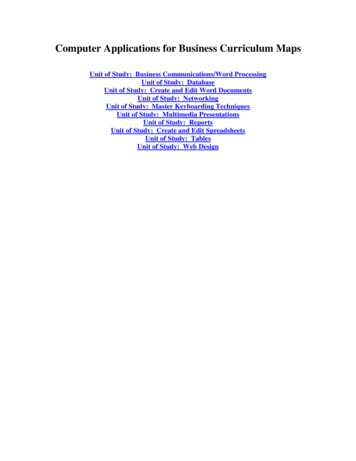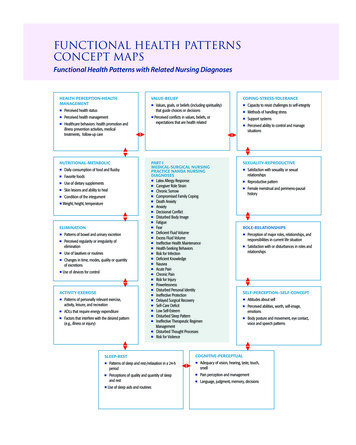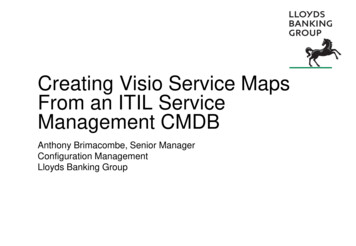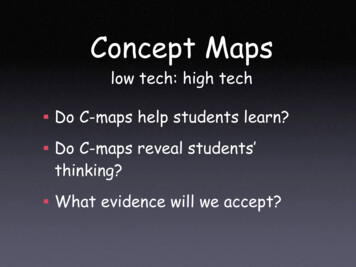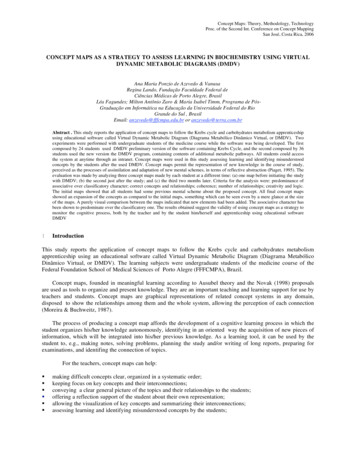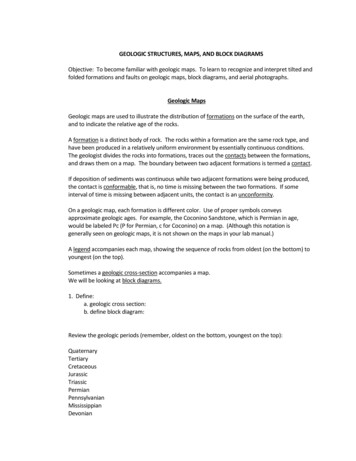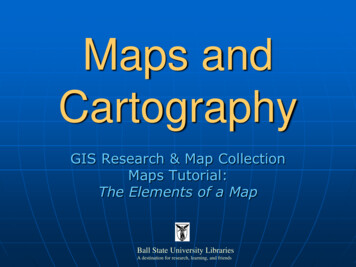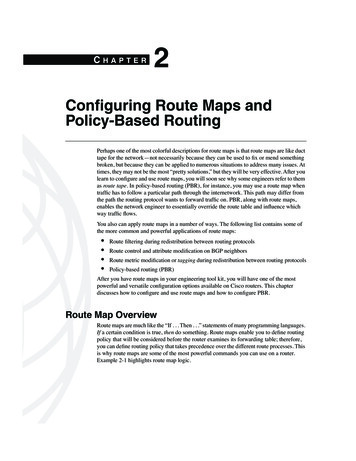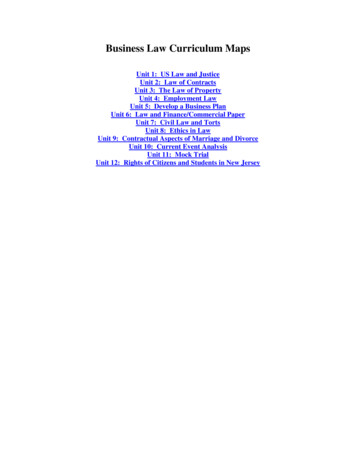
Transcription
Business Law Curriculum MapsUnit 1: US Law and JusticeUnit 2: Law of ContractsUnit 3: The Law of PropertyUnit 4: Employment LawUnit 5: Develop a Business PlanUnit 6: Law and Finance/Commercial PaperUnit 7: Civil Law and TortsUnit 8: Ethics in LawUnit 9: Contractual Aspects of Marriage and DivorceUnit 10: Current Event AnalysisUnit 11: Mock TrialUnit 12: Rights of Citizens and Students in New Jersey
Grade: 9 - 12Subject: BusinessLawUnit 1: US Law and JusticeBig Idea/Rationale To develop a realistic view of the law at workTo help distinguish between the various levels of the legal systemTo evaluate whether or not a law is achieving its intended purposeEnduringUnderstanding(Mastery Objective) Presents the historical foundation and the evolution of the U.S. legalsystem.Emphasizes the origin and the types of laws the system contains.Discusses the ethical bases for those laws.Essential Questions(InstructionalObjective) What is the difference between common law and positive law?What is the origin of the U.S. legal system?What are the four sources of law?What are the differences between the four sources of law?What are the three levels of federal courts?What are the various types of state and local courts?What are the jurisdictions of the federal and state courts?Content(Subject Matter) US Law and Justiceo Recall the history of the lawo Identify the four stages of law and distinguish between criminal,civil, procedural and substantive laws.Types of US Lawo Identify the four sources of law and distinguish between statutes,administrative regulations and case lawApply the Bill of Rights to their everyday lives.o Summarize how the amendments pertain to their lives todayo Debate the amendment they were assigned.o Identify the various types of Federal, State and Local Courts Skills/ Benchmarks(CCSS Standards) 9.4.12.L.(5).1 Analyze and summarize the roles of the three branches ofthe U.S. Government (i.e., the judicial, legislative, and executivebranches) in order to demonstrate an understanding of how governmentinfluences legal services.9.4.12.L.(5).6 Use legal terminology accurately to effectivelycommunicate within the legal services community.9.4.12.L.1 Demonstrate language arts knowledge and skills required topursue the full range of postsecondary education and careeropportunities.9.4.12.L.9 Locate, organize, and reference written information fromvarious sources to communicate with others.9.4.12.L.11 Use correct grammar, punctuation, and terminology to writeand edit documents.
Materials andResourcesNotes9.4.12.L.12 Develop and deliver formal and informal presentations usingappropriate media to engage and inform audiences.9.4.12.L.14 Apply active listening skills to obtain and clarifyinformation.9.4.12.L.26 Operate Internet applications to perform tasks.9.4.12.L.(5).9 Evaluate and model appropriate reactions to situationsinvolving Fourth Amendment rights in order to demonstrate anunderstanding of the impact this amendment has on individualsproviding legal services and their actions.9.4.12.L.(5).10 Evaluate and summarize the rights of an individual beinginterrogated under the Fifth and Sixth Amendments in order to ensuretrial, jury, and due process rights for individuals in legal servicesenvironments9.4.12.L.(5).11 Analyze and summarize the impact of the FourteenthAmendment as it relates to due process and equal protection in order toensure that legal service professionals respect the constitutional rights ofindividuals they encounter.Computer, Internet, projector, PowerPoint, Wikispaces, Wiggio, Business Law2000: Chapter 1 p.4-14, slide /studytools/ch01/studytools ch01.html#
Grade: 9 - 12Subject: BusinessLawUnit 2: Law of ContractsBig Idea/Rationale Recognize the importance of contracts in your lifeUnderstand how contracts are madeAppreciate the variety and flexibility of contractsEnduringUnderstanding(Mastery Objective) Presents the basics of contract formation as found in the matching of anoffer and a proper acceptanceIdentifies the types of agreements that are void and unenforceableIdentifies the different forms of consideration and discuses whenconsideration is requiredEvaluates the essential nature of contractual capacity and details thelegal position of those without itDiscusses agreements that have to be in writing to be enforceableExplains the contracts involved in marriage and divorce Essential Questions(InstructionalObjective) Content(Subject Matter) What are the six elements of a legally enforceable contract?What are some contracts you have entered?What are the differences between valid, voidable, and void contracts?Why does the law distinguish between executed and executor contracts?What is the difference between a unilateral and a bilateral contract?Why would someone want to avoid a contract?What are the three conditions for an offer to be valid?What events and circumstances can terminate an offer?What are the definitions of acceptance and consideration?Why isn’t an invitation to negotiate treated as an offer?Why are offers terminated upon death or disability of either offeror orofferee?Why must the offer and acceptance be identical?Which three ways does the law recognize a lack of contractual capacity?What is the difference between the remedy for misrepresentation and theremedy for fraud?What are two examples of agreements that unreasonably restrain trade?When is a written contract required?Analyze the relationships among contract law, law of sales, andconsumer law.Demonstrate common business law vocabulary.List the six essential elements of a legally enforceable contract. Studentswill be able to identify the different kinds of contracts.Create a valid offer. Describe how an offer can be terminated beforeacceptance. Understand the importance of acceptance and considerationto contract formation.
Skills/ Benchmarks(CCSS Standards) Materials andResourcesNotesDetermine if someone has the capacity to contract and how a contractcan become invalid.Identify contracts that are illegal and know when it you need to have acontract in writing.9.4.12.L.(5).1 Analyze and summarize the roles of the three branches ofthe U.S. Government (i.e., the judicial, legislative, and executivebranches) in order to demonstrate an understanding of how governmentinfluences legal services.9.4.12.L.(5).6 Use legal terminology accurately to effectivelycommunicate within the legal services community.9.4.12.L.1 Demonstrate language arts knowledge and skills required topursue the full range of postsecondary education and careeropportunities.9.4.12.L.9 Locate, organize, and reference written information fromvarious sources to communicate with others.9.4.12.L.11 Use correct grammar, punctuation, and terminology to writeand edit documents.9.4.12.L.12 Develop and deliver formal and informal presentations usingappropriate media to engage and inform audiences.9.4.12.L.14 Apply active listening skills to obtain and clarifyinformation.9.4.12.L.26 Operate Internet applications to perform tasks.Computer, Internet, projector, PowerPoint, Wikispaces, Wiggio, Business Law2000, Chapter 2 The Law of Property p. 29-55
Grade: 9 - 12Subject: BusinessLawBig Idea/RationaleUnit 3: The Law of Property EnduringUnderstanding(Mastery Objective) Essential Questions(InstructionalObjective) Content(Subject Matter)To develop a sense of what property is.Appreciate the importance of property in your life.What are a person’s rights when his/her property is transferred tosomeone else?What obligation does a person have when in possession of someoneelse’s personal property?Distinguish between real, tangible, personal, and intangible personalpropertyDetermine what body of law governs various transactions for thepurchase of goods and/or servicesDiscuss the types of intellectual propertyDiscuss seven ways of acquiring propertyDistinguish between mislaid and lost propertyIdentify some of the legal limitations on the use of propertyDistinguish between two basic ways to own propertyDescribe the features of each form of co-ownershipHow can you acquire property?What are three restrictions that exist on real property?What are the four characteristics of a bailment?How does bailment benefit society?What duties are associated with bailment?What are the two most common forms of co-ownership of property?What are the attributes?What are the different types of deeds? What are the features of each?What are restrictive covenants, easements, and licenses?What limits real property rights?What are three situations in which fair use protects the user of materialscopyrighted by another?How does the photocopy machine, CD-RWs, the Internet, etc. threatencopyright law?What kind of material can be copyrighted?How long does a copyright last?Law of Property Explain the legal rules that apply to personal property and real property. Demonstrate common business law vocabulary. Explain the concept of property, identify and explain the various types ofproperty. Understand the concept of real property and know the rights and duties
Skills/ Benchmarks(CCSS Standards) Materials andResourcesNotesassociated with real property.Identify the various bailments; know the duties associated with eachbailment.Recite the steps to properly protect their intellectual property.9.4.12.L.(5).6 Use legal terminology accurately to effectivelycommunicate within the legal services community.9.4.12.L.1 Demonstrate language arts knowledge and skills required topursue the full range of postsecondary education and career opportunities.9.4.12.L.9 Locate, organize, and reference written information fromvarious sources to communicate with others.9.4.12.L.11 Use correct grammar, punctuation, and terminology to writeand edit documents.9.4.12.L.12 Develop and deliver formal and informal presentations usingappropriate media to engage and inform audiences.9.4.12.L.14 Apply active listening skills to obtain and clarify information.9.4.12.L.26 Operate Internet applications to perform tasks.9.1.12.F.3 Defend the need for intellectual property rights, worker’srights and workplace safety regulations in the U.S. and abroad.9.1.12.F.4 Explain the impact of computer hacking on products andservices.8.1.12.D.1 Evaluate policies on unauthorized electronic access (e.g.,hacking) and disclosure and on dissemination of personal information.8.1.12.D.2 Demonstrate appropriate use of copyrights as well as fair useand Creative Commons guidelines.8.1.12.D.3 Compare and contrast international government policies onfilters for censorship.8.1.12.D.4 Explain the impact of cyber crimes on societyComputer, Internet, projector, PowerPoint, Wikispaces, Wiggio, Business Law2000 Chapter 3 p. 56-77
Grade: 9 - 12Subject: BusinessLawBig Idea/RationaleUnit 4: Employment LawThe relationship between employers and employees is based on mutual trust,responsibility and ethics.EnduringUnderstanding(Mastery Objective) Essential Questions(InstructionalObjective) Content(Subject Matter) Describe the use of agency, employment, and independent contractingby local businessDiscuss how state and federal laws affect employment relationshipsDescribe employment contractsList the types of labor relationships students may encounterDescribe labor laws in the United StatesWhat is the difference between an employer and an employee?What are the duties and responsibilities of each?What is the difference between an independent contractor and an agent?What is the difference between part-time, full-time, temporary, freelanceworkers?What are the duties of the agent to the principal?When would you utilize an agency?What is “at-will” termination?What is Title VII of the Civil Rights Act? How does it apply toemployment?What does the Equal Pay Act of 1963 prohibit?How does the government become involved in the employmentrelationship? How does it benefit the employee? The employer?What is a labor union? What services do they provide?What is collective bargaining?What is a strike? Picketing? Boycotting?What are some unfair labor practices?What does the minimum wage affect global competition?What are the different types of power of attorney?What is a non-compete clause in an employment contract?What is sexual harassment?Why is workers compensation a requirement of all employers?Analyze the role and importance of agency law and employment law.Describe rights and duties of employee, employer, and independentcontractor and other important aspects of employment.Employment Lawo Understand how and why agencies are created. Know what theagents’ and principals’ duties and authority are.o Explain the legal rights and duties involved in the employeremployee relationship. Understand how to terminate the
Skills/ Benchmarks(CCSS Standards) employment relationship.o Understand the equal employment opportunity regulations.Know about employment contracts. SWBAT understand theregulations involving job safety.Child Labor Lawso List and discuss child labor laws.o Demonstrate what they have learned about child labor lawsthrough class debateo Students will list the pros and cons of whether child labor shouldbe permitted todayWorker Safetyo Provide examples of health and safety protections in theworkplace.o Make connections between past events and present laws thatprotect the health and safety of workers.o Analyze government and organized labor solutions to aworkplace safety concern.o Recommend a solution to a workplace safety problem.o Identify actions individuals can take on their own to reduce thechance of injury or death on the job.9.4.12.L.(5).6 Use legal terminology accurately to effectivelycommunicate within the legal services community.9.4.12.L.1 Demonstrate language arts knowledge and skills required topursue the full range of postsecondary education and careeropportunities.9.4.12.L.9 Locate, organize, and reference written information fromvarious sources to communicate with others.9.4.12.L.11 Use correct grammar, punctuation, and terminology to writeand edit documents.9.4.12.L.12 Develop and deliver formal and informal presentations usingappropriate media to engage and inform audiences.9.4.12.L.14 Apply active listening skills to obtain and clarifyinformation.9.4.12.L.26 Operate Internet applications to perform tasks.WORK.9-12.9.1.12 B.4.i – SafetyWORK.9-12.9.1.12 B.4.j - Employment application skills9-12.9.3.12.C.11 Evaluate the responsibilities of employers andemployees for maintaining workplace safety, and explain health rightsrelated to a particular occupation/career.9-12.9.3.12.C.13 Comply with workplace child labor regulations andsafety and health policies during structured learning experiences.9-12.9.3.12.C.14 Interpret and justify written employer organizationalpolicies and procedures for job performance.9-12.9.3.12.C.18 Determine how an individual's driving record (e.g.,
Materials andResourcesNotestickets, points, penalties for driving while intoxicated) and/or creditscore may impact opportunities for employment, job retention, or jobadvancement.9-12.9.3.12.C.20 Analyze employment trends by industry sector todetermine how employment and training requirements change over time.9-12.9.3.12.C.21 Determine the extent to which an individual's onlinebehavior (e.g., social networking, photo exchanges, video postings) mayimpact opportunities for employment, job retention, or job advancement.9-12.9.3.12.C.22 Compare and contrast New Jersey school districtpolicies with employer policies related to individual behavior andresponsibilities (e.g., absenteeism and tardiness, plagiarism,harassment).9-12.9.3.12.C.23 Determine job entrance criteria (e.g., educationcredentials, math/writing/reading comprehension tests, drug tests) usedby employers in various industry sectors.Computer, Internet, projector, PowerPoint, Wikispaces, Wiggio, Business Law2000 Chapter 4 p. 80 –99 Employment
Grade: 9 - 12Subject: BusinessLawBig Idea/RationaleUnit 5: Develop a Business PlanInformation and technologies can be used to develop, implement, and present abusiness plan.EnduringUnderstanding(Mastery Objective) Develop good skills for writing, speaking, and listeningResearch and organize a business planUse basic math skills in businessEssential Questions(InstructionalObjective) What is the purpose of a business plan?What are the components of an effective business plan?How do you create an effective business plan with all of the essentialcomponents?Content(Subject Matter) Explain the purpose of writing a good business planDescribe the importance of a business planIdentify the seven basic elements of a business planList additional elements that may be neededResearch and organize a business planCalculate answers to math applicationsSkills/ Benchmarks(CCSS Standards) 9.4.12.D.1 Demonstrate language arts knowledge and skills required topursue the full range of postsecondary education and careeropportunities.9.4.12.D.2 Demonstrate mathematics knowledge and skills required topursue the full range of postsecondary education and careeropportunities.9.4.12.D.10 Use correct grammar, punctuation, and terminology to writeand edit documents.9.4.12.D.11 Develop and deliver formal and informal presentationsusing appropriate media to engage and inform audiences.9.4.12.D.14 Develop and interpret tables, charts, and figures to supportwritten and oral communications.9.4.12.D.23 Operate Internet applications to perform tasks.9.4.12.D.24 Operate writing and publishing applications to preparebusiness communications.9.4.12.D.25 Operate presentation applications to prepare and deliverpresentations.9.4.12.D.26 Employ spreadsheet applications to organize and manipulatedata.9.4.12.D.34 Identify new ideas, opportunities, and methods to create orstart a new project or venture.
Materials andResourcesComputer, Internet, projector, PowerPointNotesEntrepreneurship Ideas in Action Chapter 5 pp.104-127, slide presentation,Teacher created Entrepreneurship project
Grade: 9 - 12Subject: BusinessLawBig Idea/RationaleUnit 6: Law and Finance/Commercial Paper EnduringUnderstanding(Mastery Objective) Essential Questions(InstructionalObjective) Content(Subject Matter)Skills/ Benchmarks(CCSS Standards)Recognize the impact of legal requirements in the area of personal andbusiness finance.Know and be able to apply the law to checks, drafts, promissory notes,secured instruments and other debtor/creditor relationships.Covers the main types of commercial paper and distinguishes one fromanother by an analysis of their functions.Introduces students to the role and importance of commercial paper inthe U.S. free market system.What are the six types of commercial paper?What are the differences between the different types of commercialpaper?What is an Electronic Funds Transfer (EFT)?What is the function of a termination statement?What are the six laws designed to protect debtors?What are the seven examples of exempt property under bankruptcylaws?What are the different kinds of endorsements?What are the categories of tangible goods used for collateral?What are some examples of tangible goods that can be used forcollateral?Law and Finance List the various types of commercial paper, and the use and propernegotiation of each. Students will understand electronic fund transfers(EFTs). Explain why secured transactions are necessary. Describe how a securityinterest is created and enforced. Understand the laws protecting creditors and debtors. Discuss thereasons for allowing bankruptcy as an option for debtors 9.4.12.L.(5).1 Analyze and summarize the roles of the three branches ofthe U.S. Government (i.e., the judicial, legislative, and executivebranches) in order to demonstrate an understanding of how governmentinfluences legal services.9.4.12.L.(5).6 Use legal terminology accurately to effectivelycommunicate within the legal services community.
Subject: Business Law Unit 4: Employment Law Big Idea/Rationale The relationship between employers and employees is based on mutual trust, responsibility and ethics. Enduring Understanding (Mastery Objective) Describe the use of agency, employment, and independent contracting by local business
